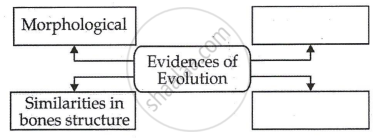Advertisements
Advertisements
प्रश्न
_____________ is a vestigial organ in human beings.
पर्याय
Wisdom teeth
Ear muscles
Body hairs
All the above
उत्तर
All the above
APPEARS IN
संबंधित प्रश्न
Which of the following pairs of two vegetables represent the correct homologous structures?
(A) Sweet potato and potato
(B) Sweet potato and tomato
(C) Carrot and potato
(D) Radish and carrot
“Two areas of study namely 'evolution' and 'classification' are interlinked'. Justify this statement.
State a reason for the increased population of dark coloured moths coinciding with the loss of lichens (on tree barks) during industrialization period in England.
Can the wing of a butterfly and the wing of a bat be considered homologous organs? Why or why not?
An example of homologous organs is
Explain the terms analogous and homologous organs with examples.
Attempt giving a clear definition of the term species.
Differentiate between analogous and homologous structures.
Wing of an insect and forelimb of a bird are :
(a) analogous organs
(b) analeptic organs
(c) homologous
(d) homophobic organs
X, Y, and Z are three animals. The animal X can fly but animal Y can only run on ground or walls. The forelimbs of animals X and Y have the same basic design but they are used for different purposes such as flying and running respectively. The animal Z became extinct an long time ago. The study of fossils of Z tells us that it had some features like those of X and some like those of Y. In fact, Z is said to form a connecting link in the evolutionary chain of X and Y.
(a) What could the animals X, Y and Z be?
(b) What name is given to the forelimbs like those of X and Y which have the same basic design but different functions?
(c) Name one feature in which Z resembled X.
(d) Name one feature in which Z resembled Y.
(e) Which is the correct evolutionary chain involving X, Y and Z : X → Z → Y or Y → Z → X?
Read the following statement and justify same in your own words with the help of suitable example.
There is evidences of fatal science among chordates.
Explain with suitable examples importance of anatomical evidence in evolution.
With the help of diagrams, describe emasculation and bagging.
Define fossil.
Differentiate between connecting links and the missing links.
Find an odd one out.
Appendix : vestigial organ : : Peripatus : ____________
Give scientific reason.
Vertebrates have slowly originated from invertebrates.
Give scientific reason.
Duck-billed platypus shows relationship with mammals.
Complete the flowchart.

Enlist the evidences of evolution.
Observe the following images and answer the questions.

- Which evolutionary evidences are indicated in the given picture?
- How are they formed?
- Which method is used to measure their age or their time?
Select vestigial organs from the following.
Homologous organs and vestigial organs are examples of ______ type of evidence in evolution.
Select the CORRECT match.
Tendons and ligaments are examples of ______.
Palaeontological evidence for evolution refers to the ______.
Organs having similar functions but different origin and development are known as:
Appearance of antibiotic-resistant bacteria is an example of ______.
Fossils are generally found in ______.
How do we compute the age of a rock?
While creation and presence of variation is directionless, natural selection is directional as it is in the context of adaptation. Comment.
Find odd one out:
Write avian characters of Archaeopteryx.
Industrial melanism in England after 1850 is an excellent example of Natural selection. Explain how?
Complete the following conceptual picture:

